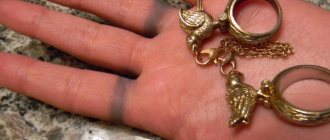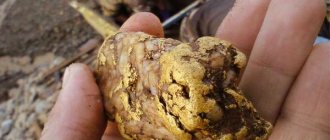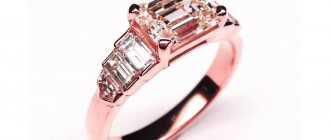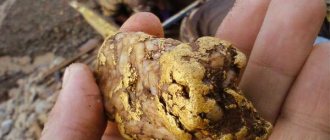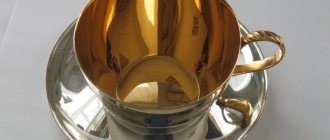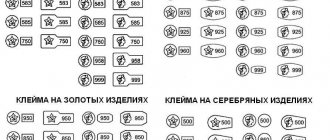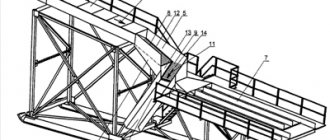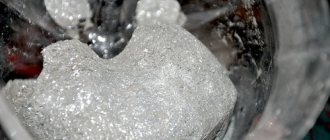Where do miners find gold in Russia?
The largest Au deposits are located in the Far East and Eastern Siberia. The third place is occupied by the Urals.
Below is a list of rivers containing the largest reserves of the yellow metal - this is where I recommend finding and washing it.
Yellow metal satellites
Companion rocks that play the role of “witnesses”, suggesting that gold-bearing veins are somewhere nearby:
- silver,
- pyrite,
- quartz,
- lead,
- galena.
Pyrite is the most insidious companion of gold, because beginners often cannot distinguish it from a real noble metal: they find a mass of pyrite crystals and rejoice at the happiness that has fallen on their heads, and then they are disappointed.
Meanwhile, gold can not only be washed from the river, but also found inside inconspicuous-looking pieces of rock scattered along the shore. If a piece of mineral glitters with a yellow tint that does not change when light is refracted, there is most likely gold inside. This breed should be crushed and washed.
Why do they wash gold in the river?
Extracting gold from the river is the most accessible way for single miners to get hold of the precious metal. To find it in river beds and wash it out of rock, you do not need to purchase expensive equipment and hire personnel, as with industrial mining from the subsoil.
There is definitely Au in the rivers flowing near gold deposits; there is a simple popular scientific explanation for this. Temperature changes and other natural phenomena destroy gold-bearing ores, small particles of the precious metal are washed away by rain, melt and flood waters into rivers and streams. After which, being heavy, gold settles in certain places:
- terrace deposits are found on rapids and sills that rise above the level of the banks of watercourses, as well as in dry riverbeds,
- Bottom placers should be looked for in bedrock channels (valleys),
- spit deposits are formed on river spits, whether sandy or pebbly.
It is good to find and wash small gold grains and large or small nuggets in bedrock, places where the flow of water slows down (the mouths of mountain streams, turns of riverbeds), natural “traps” (near boulders lying in a mountain river, on shallows, in pits under waterfalls, near fallen trees blocking the river flow).
Washing features
Before understanding how to wash gold, you should consider the features of the artisanal method of metal mining. Gold has a high density, so when river water is filtered using a sieve, its grains settle at the bottom of the tray to which the sieve is attached. At the same time, sand and particles of other rocks are washed away by water.
Even if an amateur is lucky enough to get gold by panning, he should know that this is only half the success. The thing is that gold placer always contains unreacted zinc, and to remove impurities of this metal it is necessary to treat the mined placer with concentrated hydrochloric acid. As a result of a chemical reaction, zinc is converted into salt. The next stage of gold processing is refining. This manipulation allows you to obtain high-quality metal. Refining is performed by electrolysis.
In order for gold washing to bring results, you should know that gold placers with a fraction of less than 1 mm do not settle at the bottom of the tray, which means that such particles will be washed out along with the sand. In addition, gold washing is useless if, in places where the metal is mined, its particles are deeply embedded in rock fragments.
Is it possible to mine gold in Russia?
Until 2021, only large legal entities had the right to engage in gold mining. The activities of private miners who dared to wash the precious metal were completely illegal and criminally punishable.
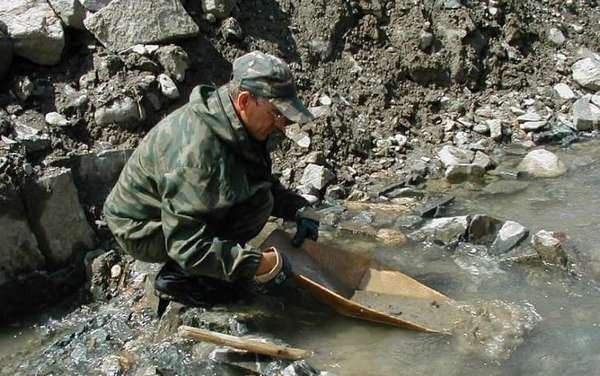
Currently, private individuals have the right to extract gold from deposits - under two conditions:
- individual entrepreneur registration,
- availability of a license or agreement with a gold mining organization that has all the permits for the development of gold mines.
Obtaining a license is a long and troublesome procedure; concluding an agreement with a licensed gold mining company is a much simpler path.
Industrial mining of precious metals brings companies quite high incomes. And private miners who want to pan for gold using the artisanal method are not competitors for them. So we can reach an agreement.
What laws regulate gold mining?
Business entities have the right to engage in gold mining in the Russian Federation, guided by the federal law “On Subsoil”, after the adoption of a number of amendments allowing both legal entities and individual entrepreneurs to mine gold from the beginning of 2021. Any private miner is given the opportunity to rent a plot of land of up to 0.15 square meters for a specified period, which is enough to extract up to 10 kilograms of precious metal.
A few more conditions must be met:
- obtain metal only by surface method,
- exclude the use of explosives,
- take soil only up to 5 meters deep.
If you wash precious metals without a license or an agreement with a company that has one, this activity is still punishable under Art. 191 of the Criminal Code of the Russian Federation. And violation of these requirements threatens with serious sanctions.
Permitted Miner's Tools
Tools that help you find and wash precious metals:
- Mini-drag for pumping rock from the bottom of the river (no deeper than 5 m) and washing it away.
- A tray in which it is convenient to wash the rock by hand.
- A metal detector that detects the presence of metal in the soil. A conventional device reacts not only to gold, but also to any metal, so I advise you to use a special metal detector with a sensor that can be easily configured specifically to search for gold.
What is a tray and why do you need a magnet?
A tray is a special device for washing rock and separating Au from it. With it you can do without a mini-dredge and get soil out of the river with an ordinary shovel.
The magnet helps separate black sand from base metals from Au.
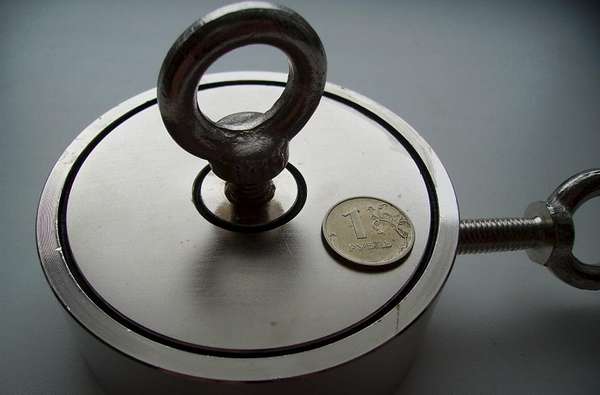
In addition to the tray and magnet, I advise you to purchase a bulb bottle, which helps you easily remove precious particles from the tray at the last step of lathering.
It is more convenient to place gold grains in a glass bottle.
Features and technology for cleaning gold coins
For cleaning coins made of valuable metals (including gold), non-contact methods are best suited. This is due to the fact that gold, in particular, is highly susceptible to abrasives: various defects can appear on the surface of the metal. If we are talking about pre-soaking in order to clean gold banknotes from heavy contamination, it is best to use low-acid solutions.
But we must not forget that such compositions require extremely careful handling. By the way, gold perfectly withstands the effects of vinegar, non-abrasive household cleaners, and citric acid (even if the product is soaked for a long period of time). But an ordinary cloth, if strongly rubbed against the surface of gold coins, can leave scratches on it, so you need to wipe the items very delicately.
It’s enough to remember a simple rule: gold coins, as a rule, do not need long-term and aggressive cleaning. Sometimes a simple soap solution and gentle cloth drying is enough.
IMPORTANT. Gold is considered a chemically inert metal, so it is reluctant to react with most naturally occurring chemicals. In addition, some of the reagents available in everyday life often either do not act on the metal or can even dissolve it.
How to properly wash gold with a tray
Now that we've sorted out the tools, I'll describe the technology for panning gold by hand.
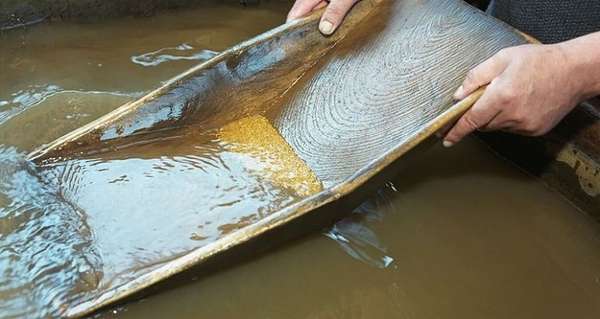
It consists of three washing stages:
- large rock and dirt,
- gravel and regular sand,
- black sand.
Washing away dirt and large rocks
- Fill the tray three-quarters full with rock, dip it into the stream so that the edges are above the surface of the water.
- Shake the tray back and forth and left and right, sharply but gently, without shaking out the gravel.
- After several shakes, we rotate the tray, moving the gravel in a circle, while most of the dirt inside dissolves.
- We remove the moss and roots and rub them over the tray with our fingers, checking to see if there are any gold particles in them.
- We take out large stones and check if they are washed.
We continue to wash with shaking and circular movements until large rocks and dirt are removed.
Washing out sand and gravel
- Holding the tray above the water surface, tilt it slightly away from you.
- We rotate it, shaking it from time to time in an upward motion, as if tossing a steak in a frying pan, but without throwing out the gravel and not letting it wash over the edge.
- Shake the tray (still in water) back and forth.
- Repeat steps 1-3 to thoroughly rinse the contents of the tray until only heavy rock remains at the bottom.
It consists of black sand, which, if the miner is lucky, contains grains of gold.
Washing out black sand
- We take the tray out of the watercourse. We do not pour out the water remaining at the bottom; it will be useful at the last stage of washing.
- We tilt the tray a little and slowly turn it in a circle, checking if there are any precious pieces of gold or small nuggets at the bottom. If there is any, remove it and put it in a container for storing the “catch”.
- Slowly pass a magnet over the black sand. Black sand sticks to it, separating from the golden grains.
- We take a pear bottle, squeeze it and, unclenching it, suck up the gold and water from the tray.
- Pour the remaining black sand and gold grains into a container for precious metal.
You can finish washing and cleaning black sand, extracting the smallest Au particles from it, at home.
Preparing coins and necessary tools
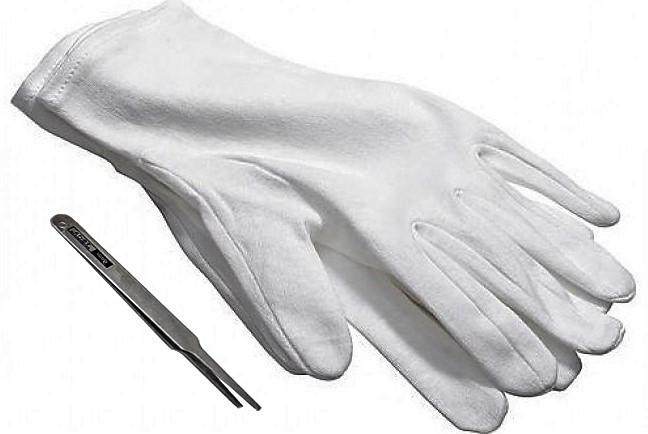
Before you begin the process of cleaning gold coins from old contaminants, you need to prepare both reagents and all the tools for effective work. The first ones can be soap solution, citric acid (as an alternative - vinegar), soda, etc.
As for tools, first of all you need to stock up on a pair of gloves (any fabric construction gloves will do) or special numismatic tweezers with rubberized ends, microfiber or any natural fabric (for drying coins) and a bath for soaking.
After all the working elements are prepared, you can begin to pre-clean the coins themselves. First, all dirt is cleaned: it is enough to immerse the banknote in warm water for a while, then carefully remove visible dirt, acting very delicately, since they may contain abrasive particles. The next preparatory stage is thorough washing in clean water, and then degreasing the surface of the products.
Choosing a place to wash gold
Tips on how to choose the best place to extract the richest rock from the water and wash the yellow metal with the greatest benefit:
- Search on a river or in a stream from the list of the most “gold-bearing” ones, not far from the place of industrial mining - after it, not only the smallest grains of gold remain, but also whole nuggets, which are enough for everyone.
- Choose a section of the watercourse with a depth of more than 15 centimeters so as not to wash the metal in too dirty water full of small debris.
- Choose a section of the river with a relatively slow (slow) flow.
- If you're lucky, find a place with a large stone or a fallen tree where you can sit down so as not to wash the precious metal while standing.
All about gold panning

join the discussion
Share with your friends
Gold is one of the most expensive types of metal, which is often used in the jewelry industry. People learned to extract it many years ago, and even today gold miners travel to different places to discover deposits of this metal. Small particles of material are often carried away by rivers, so prospectors purchase washing equipment and go hunting.
Top 10 Russian rivers rich in gold reserves
The Golden Ten watercourses, where there are a lot of reserves and it’s profitable to wash:
- Alekseevsky stream (Kamchatka),
- Bodaibo River (Irkutsk region),
- tributary Bolshoy Chanchik (ibid.),
- Bom River (Amur region),
- Jalon stream (ibid.),
- Lena River and its basin,
- Millionny stream (Amur region),
- Unakha River (ibid.),
- Sanarka River (Chelyabinsk region),
- Talga River (Khabarovsk Territory),
At Bodaibo and Millionnoye they wash the rock and extract the largest gold particles. Nuggets are also found in these and other watercourses.
How to clean gold: effective ways
It never hurts to know how to quickly clean gold at home. For example, in case there are literally a few minutes before leaving, and the only pair of earrings or pendant that matches the look looks, to put it mildly, unmarketable. There are always suitable means for cleaning gold at home - don’t waste time and restore the attractiveness of your jewelry.
Ammonia
Cleaning gold at home with ammonia or ammonia is the easiest way to get rid of cloudiness of the precious metal and stains on jewelry. To effectively clean gold from blackness, you need to make a solution of water and ammonia with the addition of shampoo. Recommended proportions for a small container of warm water: 0.5 tsp. ammonia and 1 tsp. shampoo. Completely immerse the jewelry that requires cleaning into the resulting solution and mix; after removing the dirt, rinse the gold thoroughly in running water.

Gold rings in ammonia solution
In this way, you can soak gold with some stones: the ammonia solution perfectly removes dirt and oxides from hard-to-reach places. To dry, simply place the jewelry on a paper napkin or towel.
In particularly difficult cases, it is allowed to use ammonia with a high concentration, without dilution with water
Hydrogen peroxide
Hydrogen peroxide is also an effective and affordable liquid for cleaning gold. For minor stains, it is enough to wipe the jewelry with a cloth soaked in peroxide. In other cases, a more aggressive method is recommended:
- Make a solution: 1 glass of warm water, 30 mg of hydrogen peroxide (3%), 1 tsp. ammonia, a small amount of liquid soap (by eye).
- Mix the ingredients thoroughly.
- Immerse gold items in a container with the solution and leave for 3-5 hours.
- Rinse the jewelry with plain water and dry it on a napkin.
Vinegar
You can clean a gold chain, bracelet or ring using regular white 9% or apple cider vinegar, with the addition of soda or lemon. Please note that only yellow and red gold can be cleaned with vinegar; this method is unacceptable for white, matte or inlaid with stones.

You can use a toothbrush to clean gold.
In some cases, it is enough to simply soak the products in vinegar for 10-15 minutes, then rinse with water; in others, you will need to brush the surface with a toothbrush.
Baking soda will help clean gold from dirt, but it does not always cope with difficult stains. Most often, boiling with soda is used for cleaning:
- Place foil at the bottom of a small container of water and place gold on it.
- Heat water and add soda - 1 tbsp. water 1 tbsp. soda
- Boil for a few minutes.
- Clean with a brush.
- Rinse with plain water and dry.

Baking soda is not used to clean jewelry with inserts.
: it can cause tarnishing of stones, and the soda solution can also remain in hard-to-reach places of fastenings with a whitish coating.
Salt is typically used as an addition to vinegar or baking soda cleaning solutions. Due to the strong abrasive nature of salt, we do not recommend mechanical cleaning of soft gold items.
Lemon acid
To dissolve plaque, you can clean gold in citric acid:
- Dilute citric acid in boiling water;
- immerse the products in the solution for 5-6 minutes;
- rinse and dry jewelry.
